B2B Content Marketing Ideas: Top 5 Examples You Should Check Out

It’s been almost two decades into the 2000s, but still, many organizations are not using content marketing effectively. That’s unfortunate because the majority of content marketers (71%) indicate that content has only become more important than ever in the last ten years.
These facts about having a content marketing strategy in place might surprise you:
- Content marketing can be 60% less expensive than traditional forms of marketing.
Now, that’s budget-friendly for any savvy marketer. But most importantly, it’s not just about cost-efficiency.
- Contact marketing can generate 3x more leads than native marketing.
It’s a one-two punch of cost-effectiveness and efficiency that’s hard to ignore. From driving traffic to generating leads and fostering trust and brand loyalty among the target audience, the benefits of content marketing know no bounds.
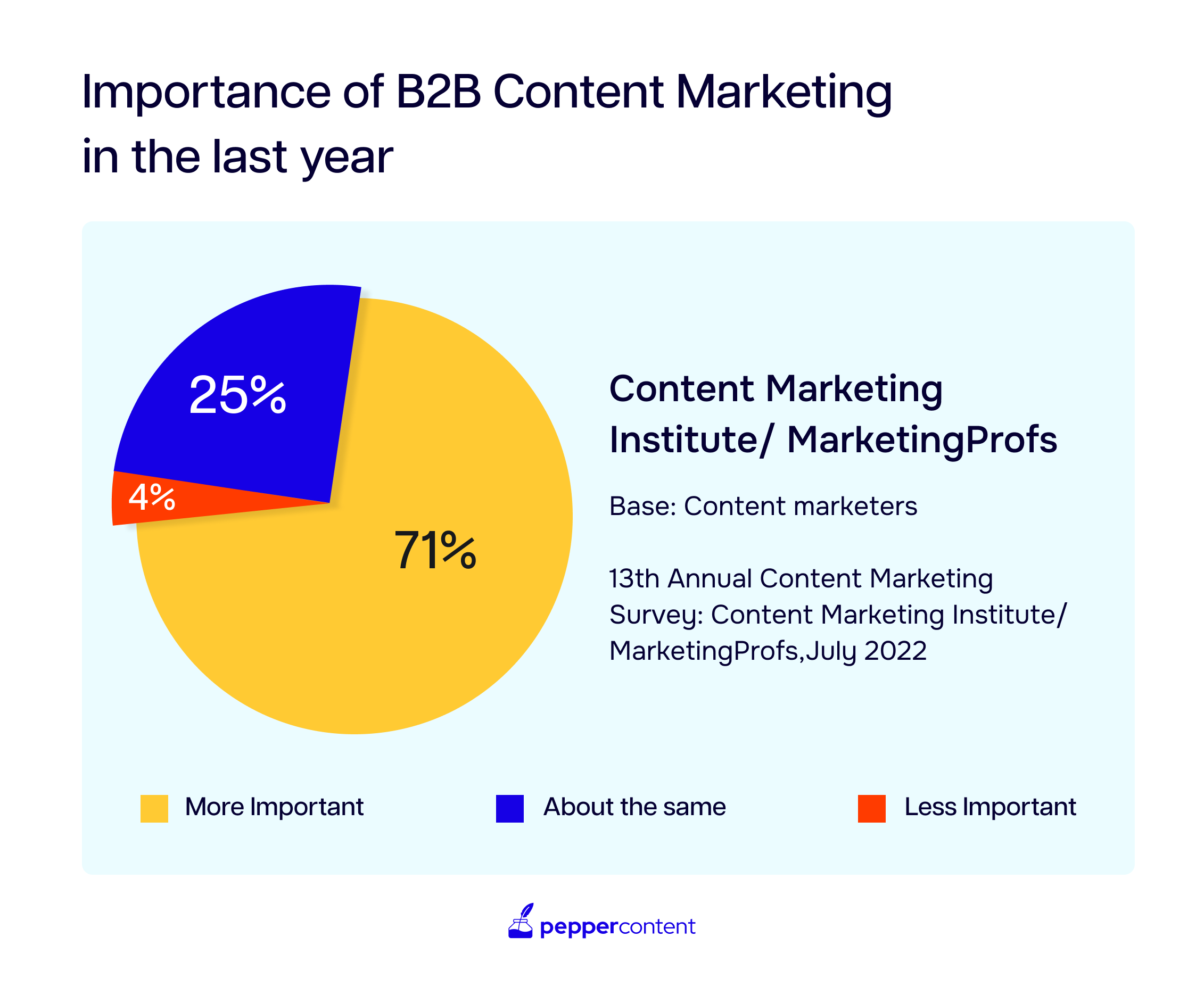
Now, B2B enterprises allocate an average of $185,000 annually towards their content marketing endeavors, with this figure steadily on the rise. While this number underscores the significance of effective content marketing, it also highlights a critical point: Your B2B organization cannot afford a content strategy that falls short in reaching, engaging, or inspiring customers to take action.
Additionally, with as many as 80% of B2B organizations using content marketing strategies to accomplish their business objectives and almost 50% of marketers anticipating budget increases in the next year, the industry is becoming more crowded than ever.
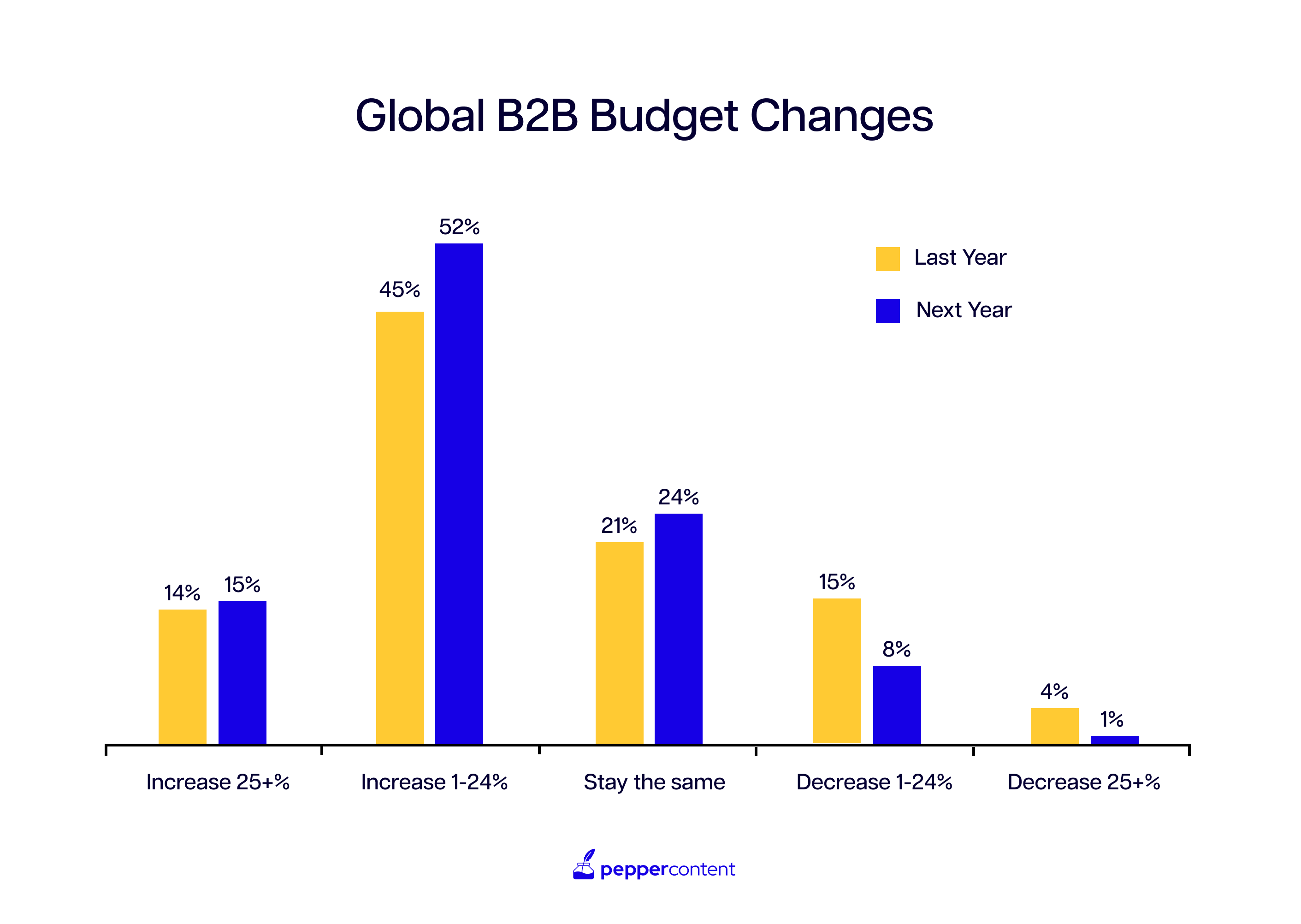
This means that your company needs to create content that not only reaches your target audience but also convinces them of why your product is better compared to all your competitors.
Ty Heath, the Director of Market Engagement at LinkedIn’s B2B Institute, says:
“Most of your growth potential lies in reaching people who won’t buy from you today but who will buy from you in the future.“
But what exactly do you need to undertake to get the most out of your content planning? Well, to get to the bottom of this, we need to first look at the challenges of creating engaging, high-quality B2B content.
Challenges of Producing High-Quality, Engaging B2B Content
You may consider it straightforward: Write, publish, and attract more target audience. However, content marketing is much more complex and requires effort and careful planning than merely putting out a couple of blog posts. The major challenge that most B2B and B2C companies face is that the content they produce doesn’t engage their target audience.
A 2022 study by the Content Marketing Institute (CMI) indicated that the number one challenge for B2B organizations is difficulty in creating content that appeals to the different stages of the buyer’s journey. And only a mere 2% of marketers say that they do not face any challenges.
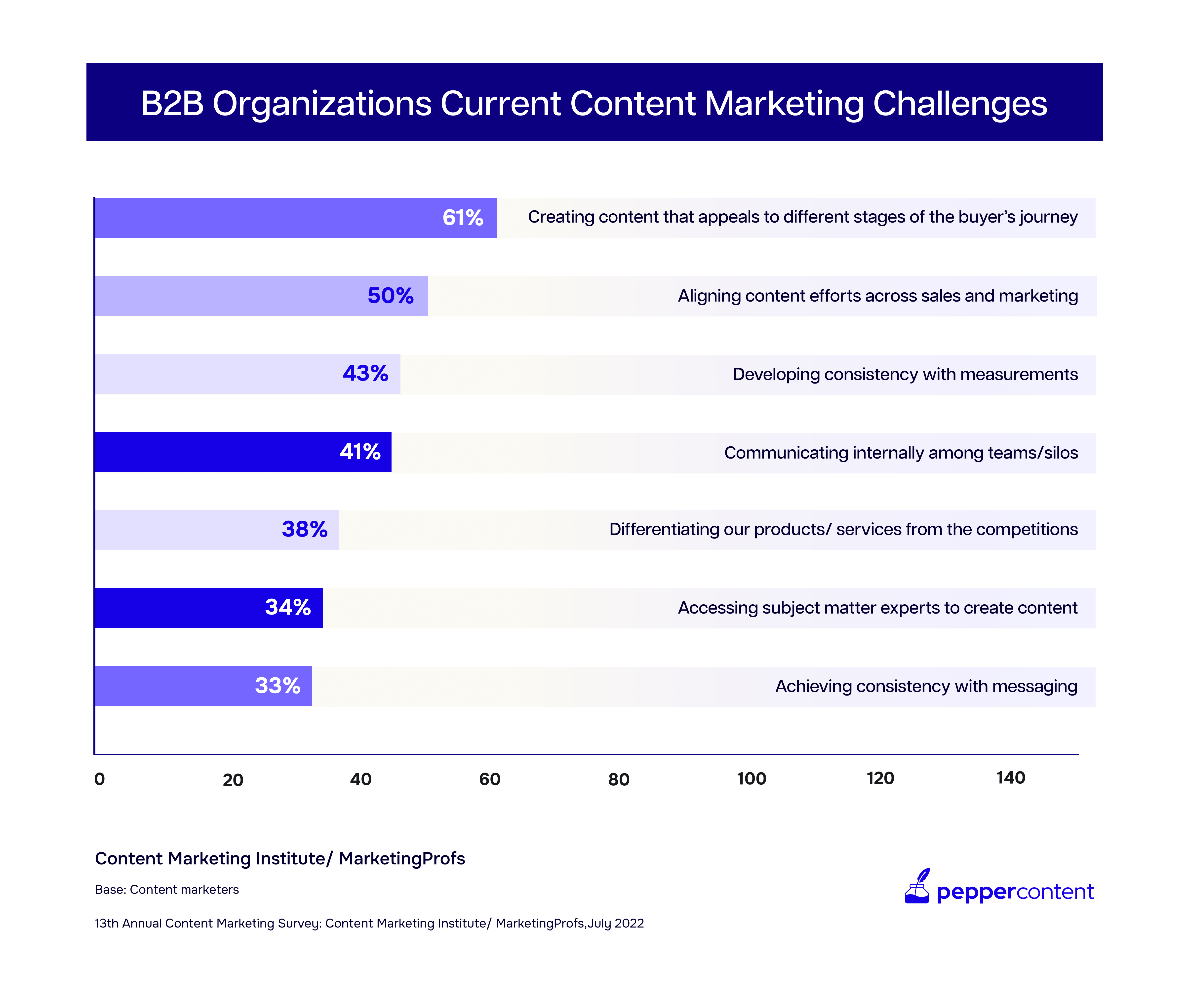
The thing is, if you lack engaging content, it sets off a chain reaction, pushing all your marketing efforts to failure.
Gaining support from the C-suite and getting a substantial budget for your content marketing plan hinges on showing its efficiency in attracting more customers, boosting conversions, and driving sales. However, without content that delivers results, you won’t get the necessary support and resources for its production. This creates a vicious cycle, making it a challenging scenario.
Given below are some of the key steps you need to follow to create engaging, high-quality content:
- Know Your Audience: Understand who your audience is, what they’re interested in, and where they spend their time online. Use web analytics to gather insights on their preferences and behavior on your website.
- Provide Valuable Information: Conduct thorough industry research to offer expert insights and address common questions your potential customers may have. This establishes your brand as a trusted source in your niche.
- Optimize Distribution Channels: Understand where and when your target audience is most active online. This influences not only what you post but also where and when you share it. Study your competition’s strategies and keep an eye on industry trends.
- Leverage SEO Insights: Use SEO evaluations and content audits to find opportunities for creating content that targets audiences in the middle and bottom of the sales funnel.
- Tell Compelling Stories: Incorporate storytelling into your content to make it more relatable and engaging for your audience. This helps create a deeper connection with your brand.
Now that we know how to create a content marketing strategy that actually works, let’s look at 5 different B2B content marketing ideas!
5 B2B Content Marketing Examples That Actually Work
Our content strategy must adapt to align with the shifting preferences and priorities of our post-pandemic audience.
A study by the Content Marketing Institute revealed that the most popular content types leveraged in the last 12 months are short posts/articles, videos, and case studies/consumer stories.
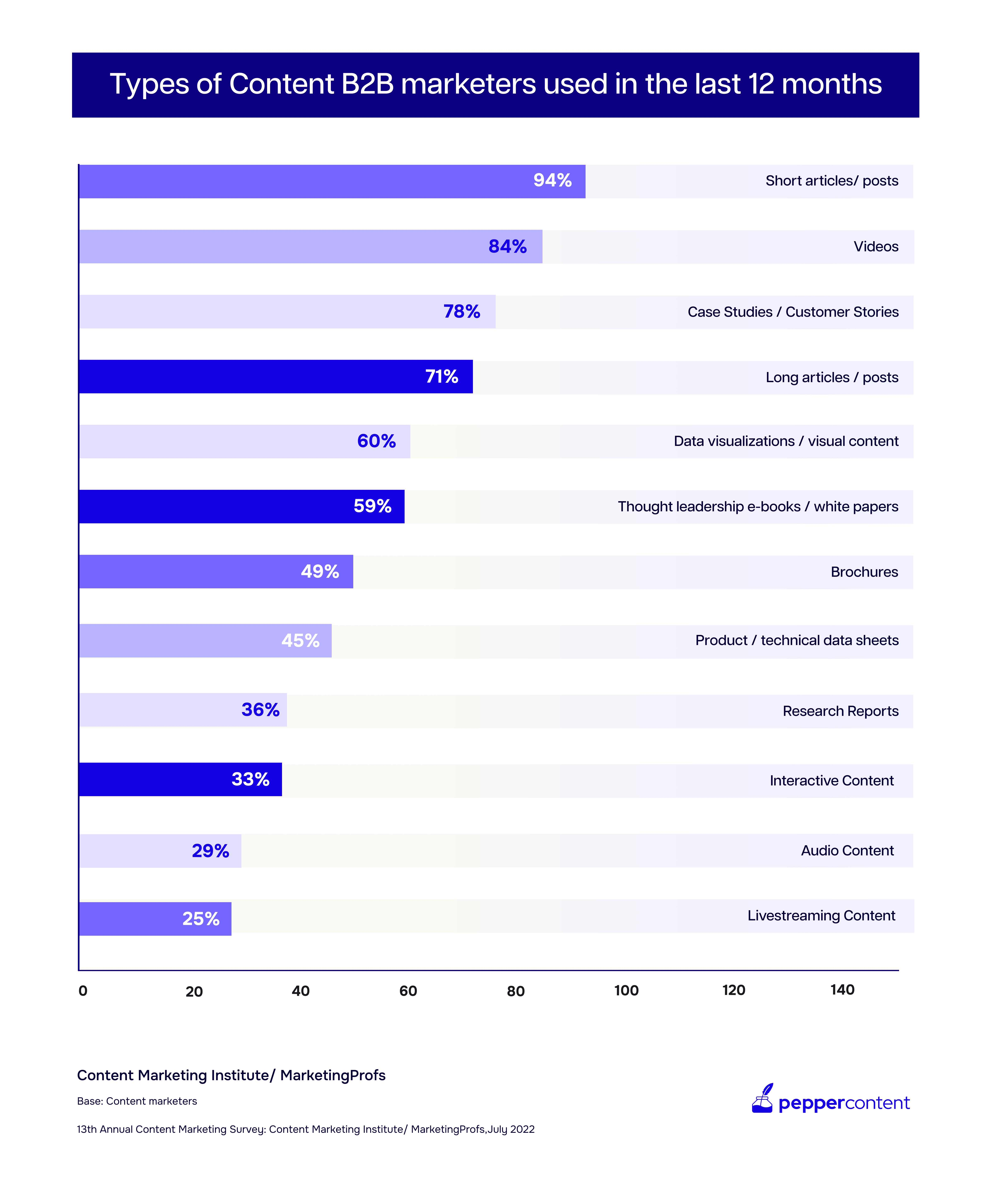
B2B marketing leaders identified in-person events as the most effective marketing channel. In fact, 3 in 5 B2B marketing leaders plan to use thought leadership techniques in the following year, on par with in-person events and video.
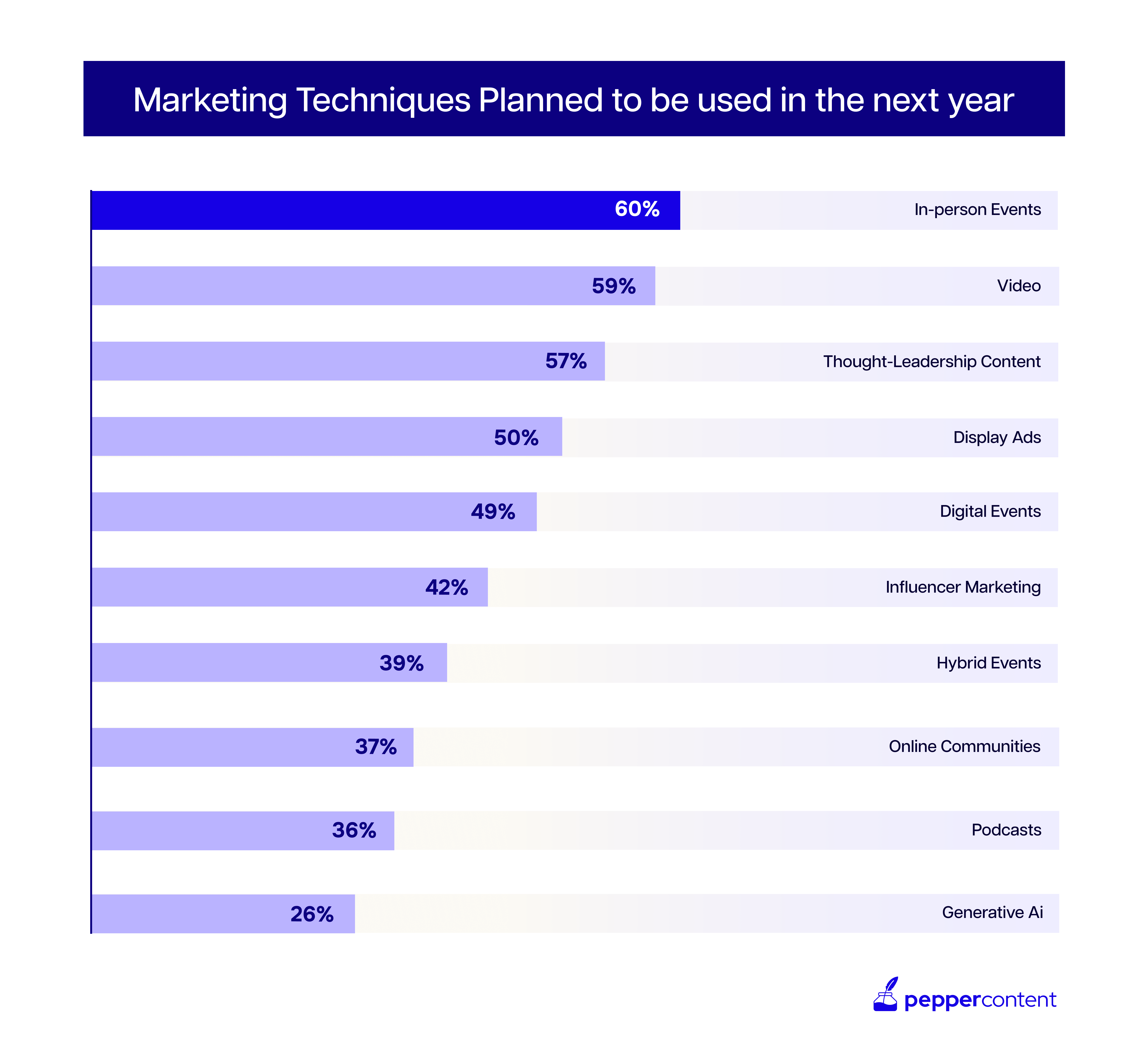
Below are some of our top B2B content ideas, each showcasing distinct marketing tactics that you can incorporate into your own strategy.
1. Thought Leadership with Whitepapers and Case Studies
Becoming a thought leader requires a combination of in-depth expertise and acknowledgment from peers for your ability to drive innovation in your industry.And who wouldn’t want to work with a company that serves as an inspiration for others?
Thought leadership content — including case studies and whitepapers — often takes the form of detailed pieces, including original research. A prime example is marketing expert Neil Patel, who leverages videos, blogs, and social media to share insights, educate, and express opinions on various marketing topics.
IBM, a U.S.-based technology company, is yet another example that demonstrates a successful approach to thought leadership content marketing. They focus on providing valuable insights and practical guidance to overcome B2B marketing challenges. By sharing market trends and industry insights, they establish themselves as trustworthy thought leaders.
For instance, by offering detailed case studies or whitepapers on effective account-based marketing and leveraging data analytics for targeted campaigns, IBM’s content not only educates but also equips businesses with solutions they can implement. This strategy enhances brand credibility and positions IBM as an expert in the B2B marketing sphere.
If you want to create compelling case studies and whitepapers, you need to inspire and educate potential buyers through your thought leadership content. Think about the problems that your product or service already aims to solve for customers. Then, turn that into relevant content that’s going to both save time for and inform your audience — and make it easy for them to access it.
2. Webinars and Live Events
We all know that stories work better than facts, and what better way to engage your audience through storytelling than hosting webinars?
A webinar is a powerful tool to educate, connect, and ultimately sell to a diverse audience at a relatively low cost. Regardless of your industry or target audience, webinars have the potential to enhance your marketing and sales endeavors significantly.
Over 99% of B2B marketers say webinars are key to their future marketing strategy.
HubSpot, a leading provider of inbound marketing and sales software, leverages webinars to showcase its expertise and generate leads.
One brilliant example is their webinar titled “The Science of Email Marketing.” This free, hour-long webinar imparts valuable insights and actionable tips for crafting successful email marketing campaigns. Hosted by HubSpot’s expert marketing team, it covers crucial topics like email list segmentation, best practices in email design, and implementing email automation.
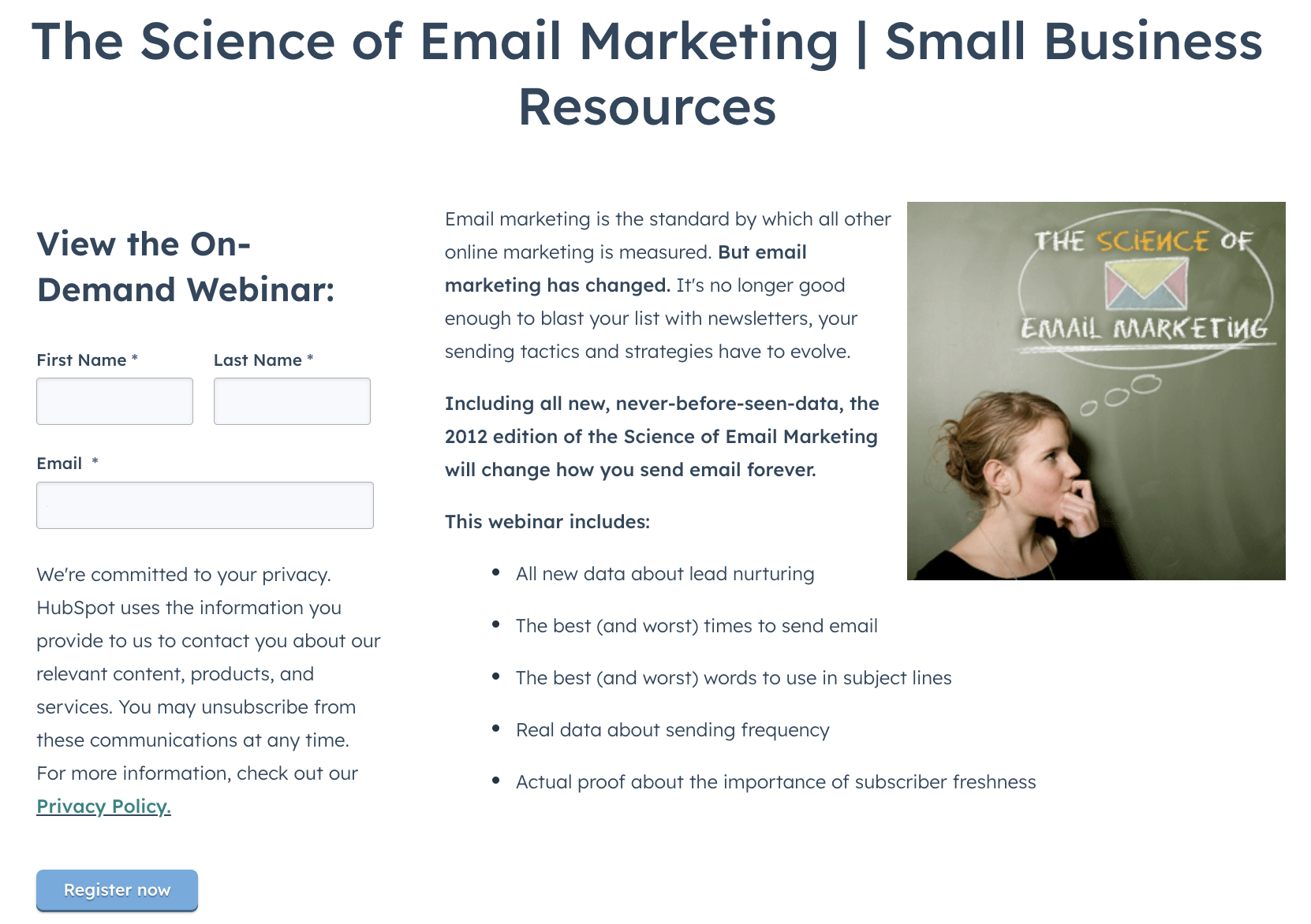
The results garnered from HubSpot’s webinar are nothing short of impressive. Within a year, the HubSpot webinar generated over 20,000 leads and $250,000 in sales, boasting a conversion rate of 12%. Additionally, it has been viewed more than 75,000 times, earning a satisfaction rating of 94% from attendees.
HubSpot’s success with webinars can be attributed to several pivotal factors:
- They meticulously identified their target audience. Their webinar was designed to offer practical insights and strategies for leveraging LinkedIn Ads to generate leads.
- What sets HubSpot apart is its engaging and knowledgeable marketing team, capable of delivering insights and tips that are both accessible and easy to implement.
- They executed a comprehensive marketing strategy that included blog posts, social media ads, and email campaigns to ensure maximum reach and drive registrations.
To create a successful webinar, it’s crucial to state the value you offer to your audience clearly. Do not focus solely on your company, product, or service but on demonstrating why they should choose you. This holds particular weight in webinars, as your audience can easily exit with just a click.
Their investment in attending is minimal, so your message must be compelling to retain their attention.
3. Engaging Newsletters
The main goal of having a B2B newsletter is to build a community by sharing what’s going on with your brand. Newsletters have evolved from providing mere updates to becoming a powerful marketing tool that provides value-driven content, subsequently keeping your audience informed and engaged.
A brand that has mastered the art of the B2B newsletter is CB Insights.
Janessa Lantz, Senior Marketing Manager at HubSpot, says:
“There are two things I love about the CB Insights newsletter. First, it’s surprisingly funny (the subject lines alone make it worth it). Second, you learn a lot just by reading the newsletter; no need to click through a bunch of links.“
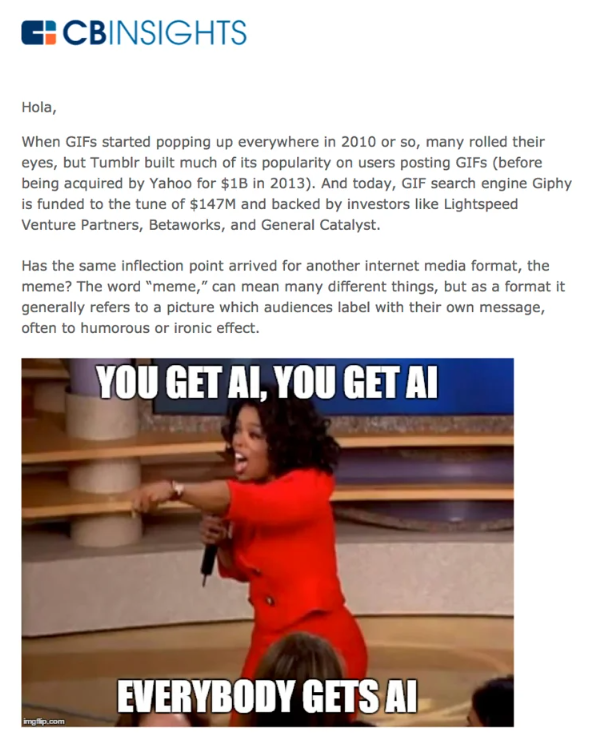
Image Source: CB Insights
Even though they include funny content marketing ideas for B2B newsletters, their messaging is consistent and personalized. The company designs technology for individuals in the VC space, requiring content that resonates with a wide spectrum of readers: existing and potential customers, tech specialists, and investors alike.Hence, amidst subject lines like “so sad: tough to have a VC dad,” they include meaningful information. While their GIFs might be entertaining, in specific contexts, they can also hold a value of $147 million.
The takeaway?
When you’re eager to make really cool and cutting-edge content, it’s easy to go off track from what your organization is all about. So, even though it’s good to be creative with catchy titles or add humor to your emails, make sure you’re sharing the kind of information people signed up for.
And always remember to maintain a human touch throughout — by being friendly and relatable.
4. Memes
Memes are popular ideas or jokes that spread quickly on the internet. They can be in different forms like GIFs, videos, images, or messages.
According to Hubspot, “Meme marketing is the use of memes to promote your brand narrative. It’s a fun, low-effort way to connect with your audience and increase your engagement rate, as memes are highly shareable.”
Big brands like HubSpot, Hootsuite, and Slack use memes to gain attention and make more people interested in what they do. But did you know if you link a meme to your company’s product value, it can act as top-of-the-funnel awareness-type content?
MailChimp, for example, leverages memes to help more people know about their brand in a fun and enjoyable way:
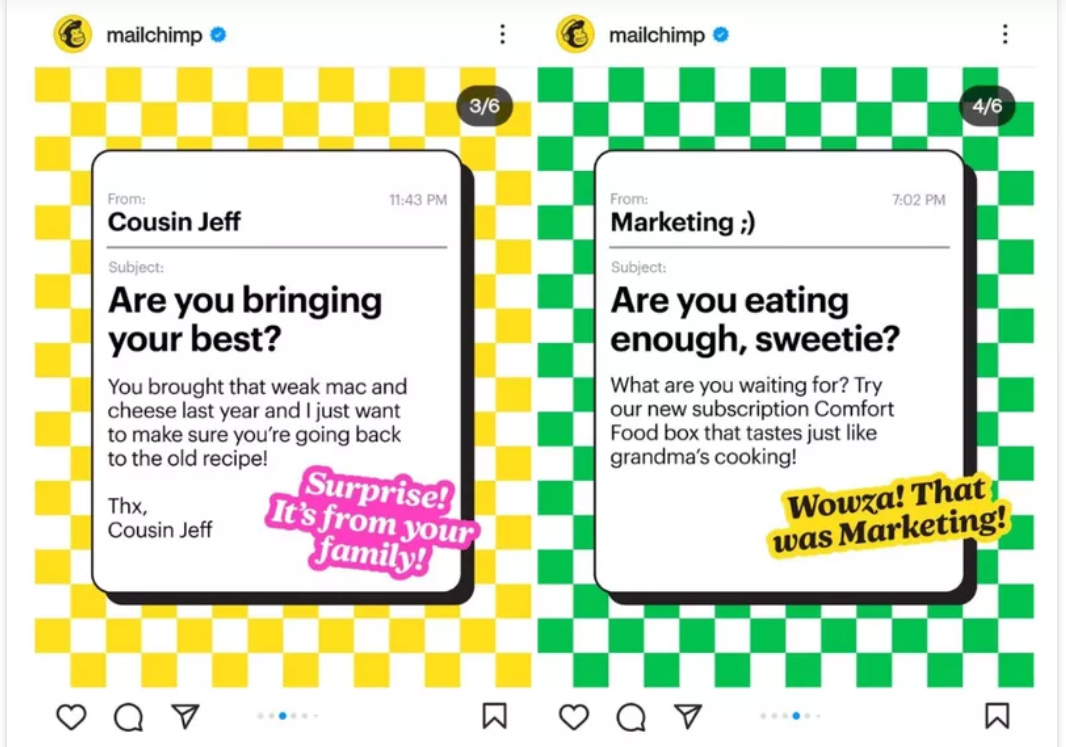
Here’s another excellent example of B2B meme marketing from the social media management platform Hootsuite:
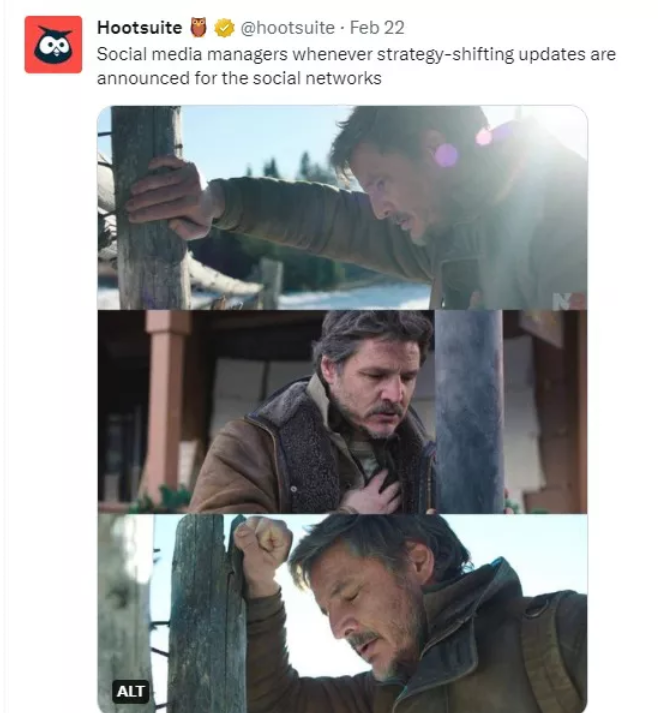
Hootsuite’s meme marketing strategy portrays how social media managers feel when there’s a big change in how they plan things. It’s like starting all over again for a whole month. That’s why this meme strategy works — it taps into the right emotion!
Here are some key tips for successful B2B meme marketing:
- Know Your Audience: Understand who your target audience is so your memes resonate with them. For instance, Zapier used a meme that speaks directly to its users who rely on workflow automation.

- Mind the Tone of Voice: Keep the tone of your meme in check. It should be funny, relatable, and informative while still aligning with your brand’s style.
- Ride the Trends: Timeliness matters in meme marketing. Jump on popular topics related to your product and audience.
Listen, Track, and Optimize: Pay attention to how your audience responds to your memes. Use analytics to fine-tune your approach and ensure your memes are hitting the right notes across different platforms.
5. Podcasts: The Growing Medium for B2B Knowledge Sharing
Podcasts are a highly influential form of B2B outbound marketing leveraged for both learning and enjoyment over the last couple of years. They provide an excellent platform for storytelling, can dive into niche topics, and are useful for establishing authority.
A study by Podcast Insights suggests that 75% of Americans are now familiar with it, and nearly 55% listen to podcasts regularly. Additionally, a 2022 Hubspot survey found that approx. 82% of B2B marketers prefer podcasts and invest in producing audio content.
Hosted by Benji Block, The B2B Growth Show by Sweet FishMedia is a popular US B2B interview podcast that covers all aspects of marketing. This podcast works because it not only shares practical tips on growing a business but also improves the overall B2B marketing strategy. It’s so easy to understand, and it’s like they’re teaching you step by step.

Below are the practical tips for creating a podcast and building a subscriber base:
Choose Hosting Platform: Pick a platform (like Libsyn, Podbean, etc.) to publish and make your podcast look good. It’s like WordPress for blogs.
Upload Three Episodes: Have at least three episodes ready to go for your launch. This helps convince people to subscribe and gets you noticed by Apple Podcasts.
Register in Directories: Make sure your podcast is listed in directories like Apple Podcasts, Google Podcasts, and others. This is where people will find you.
Promote Internally: Encourage your team to subscribe, rate, and review your podcast. Also, ask them to spread the word on social media.
Activate Influencers: If you have industry experts on your podcast, let them know when their episode is live. Provide them with tools to promote it.
Publish Blog Posts: Embed each episode in a blog post. This helps with SEO and makes your content more accessible.
Consider Paid Promotion: Use paid social media ads or cross-promotion on other podcasts to reach your target audience.
Ask for Listener Feedback: Encourage listeners to leave ratings and reviews. It helps build credibility and visibility.
Stick to a Schedule: Be consistent in publishing episodes. Let your audience know how often they can expect new content.
Repurpose Content: Use snippets for social media, turn them into videos, and reuse transcripts for blog posts or quotes.
Remember, the key is to keep things consistent and engage with your audience.
What’s Next?
Don’t worry if creating and distributing your B2B content seems overwhelming and challenging at first. Remember that building trust takes time, but if you’re seeking expert help in B2B content creation, Pepper Content is here to assist you with everything! Our advanced B2B content marketing ideas can help you attract and engage your target audience, build trust in your brand, and form long-lasting customer relationships.
Book a demo now to turn your idea into a selling powerhouse!
Latest Blogs
Learn how to rank on AI search engines like ChatGPT, Perplexity, and Gemini by optimizing your content for authority, structure, and relevance. Stay ahead in AI-driven search with this strategic guide.
Explore the best healthcare SEO services for your medical practice. Improve online visibility and effectively reach more patients in need of your services.
Discover top social media agencies specializing in banking solutions, enhancing financial services and driving engagement.
Get your hands on the latest news!
Similar Posts

Content Strategy
5 mins read
Choosing The Best Healthcare Marketing Agency For Effective Content Solutions
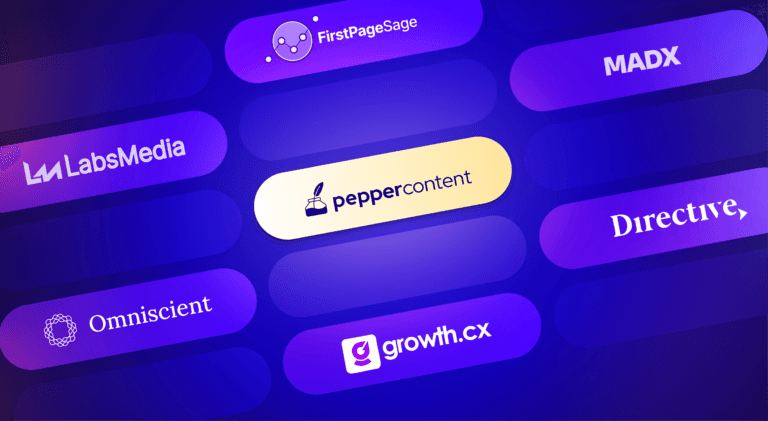
Content Marketing
4 mins read
Top 10 Agencies B2B SaaS Content Marketing for B2B Success

B2C Marketing
5 mins read